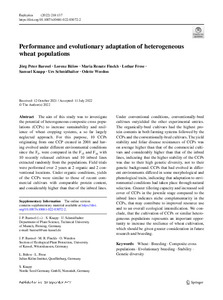| dc.date.accessioned | 2022-09-09T10:37:18Z | |
| dc.date.available | 2022-09-09T10:37:18Z | |
| dc.date.issued | 2022-09-03 | |
| dc.identifier | doi:10.17170/kobra-202209096840 | |
| dc.identifier.uri | http://hdl.handle.net/123456789/14140 | |
| dc.description.sponsorship | Gefördert im Rahmen des Projekts DEAL | ger |
| dc.language.iso | eng | |
| dc.rights | Namensnennung 4.0 International | * |
| dc.rights.uri | http://creativecommons.org/licenses/by/4.0/ | * |
| dc.subject | wheat | eng |
| dc.subject | breeding | eng |
| dc.subject | composite cross populations | eng |
| dc.subject | evolutionary breeding | eng |
| dc.subject | stability | eng |
| dc.subject | genetic diversity | eng |
| dc.subject.ddc | 580 | |
| dc.subject.ddc | 630 | |
| dc.title | Performance and evolutionary adaptation of heterogeneous wheat populations | eng |
| dc.type | Aufsatz | |
| dcterms.abstract | The aim of this study was to investigate the potential of heterogeneous composite cross populations (CCPs) to increase sustainability and resilience of wheat cropping systems, a so far largely neglected approach. For this purpose, 10 CCPs originating from one CCP created in 2001 and having evolved under different environmental conditions since the F5, were compared in the F15 and F16 with 10 recently released cultivars and 10 inbred lines extracted randomly from the populations. Field trials were performed over 2 years at 2 organic and 2 conventional locations. Under organic conditions, yields of the CCPs were similar to those of recent commercial cultivars with comparable protein content, and considerably higher than that of the inbred lines. Under conventional conditions, conventionally-bred cultivars outyielded the other experimental entries. The organically-bred cultivars had the highest protein contents in both farming systems followed by the CCPs and the conventionally-bred cultivars. The yield stability and foliar disease resistances of CCPs was on average higher than that of the commercial cultivars and considerably higher than that of the inbred lines, indicating that the higher stability of the CCPs was due to their high genetic diversity, not to their genetic background. CCPs that had evolved in different environments differed in some morphological and phenological traits, indicating that adaptation to environmental conditions had taken place through natural selection. Greater tillering capacity and increased soil cover of CCPs in the juvenile stage compared to the inbred lines indicates niche complementarity in the CCPs, that may contribute to improved resource use and to an overall ecological intensification. We conclude, that the cultivation of CCPs or similar heterogeneous populations represents an important opportunity to increase the resilience of wheat cultivation, which should be given greater consideration in future research and breeding. | eng |
| dcterms.accessRights | open access | |
| dcterms.creator | Baresel, Jörg Peter | |
| dcterms.creator | Bülow, Lorenz | |
| dcterms.creator | Finckh, Maria Renate | |
| dcterms.creator | Frese, Lothar | |
| dcterms.creator | Knapp, Samuel | |
| dcterms.creator | Schmidhalter, Urs | |
| dcterms.creator | Weedon, Odette Denise | |
| dc.relation.doi | doi:10.1007/s10681-022-03072-2 | |
| dc.subject.swd | Weizenanbau | ger |
| dc.subject.swd | Längsschnittuntersuchung | ger |
| dc.subject.swd | Rendite | ger |
| dc.subject.swd | Inzuchtlinie | ger |
| dc.subject.swd | Konventionelle Landwirtschaft | ger |
| dc.subject.swd | Biologische Landwirtschaft | ger |
| dc.subject.swd | Pflanzenzüchtung | ger |
| dc.type.version | publishedVersion | |
| dcterms.source.identifier | eissn:1573-5060 | |
| dcterms.source.issue | issue 10 | |
| dcterms.source.journal | Euphytica | eng |
| dcterms.source.volume | Volume 218 | |
| kup.iskup | false | |
| dcterms.source.articlenumber | 137 | |


